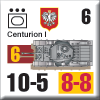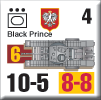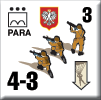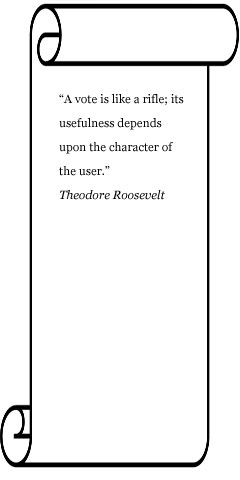| Panzer Grenadier: Polish Steel
Scenario Preview
October 2013
 Polish Steel is a Panzer Grenadier scenario supplement involving the Polish divisions that helped occupy Germany after World War Two. The different Polish divisions would have been armed with state of the art weaponry from either the American or the British arsenals, meaning each division’s capabilities would depend largely on which nation had supplied its armaments. Polish Steel is a Panzer Grenadier scenario supplement involving the Polish divisions that helped occupy Germany after World War Two. The different Polish divisions would have been armed with state of the art weaponry from either the American or the British arsenals, meaning each division’s capabilities would depend largely on which nation had supplied its armaments.
In the scenarios, the Poles strike eastward across the Soviet occupation zone toward Poland with the intent of sparking a popular uprising there against the Soviet occupiers. Here's a look at them.
Scenario One
Wilhelmshaven
July 1948
Soon after the disastrous American attempt to break the Berlin Blockade in June 1948, Soviet armored spearheads struck into the American and British Occupation Zones in western Germany. The withdrawal of US forces three years earlier to the lines agreed upon at Yalta gave the Soviets a ready-made salient from which to attack the British and Americans simultaneously. The British caught the worst of it and were driven back to the North Sea coast, with the port of Wilhelmshaven dubbed “The New Dunkirk” but holding out better than its predecessor due to its protected position on the Jadebusen.
That gave the recently demobilized Polish I Corps time to muster in Britain and ship out to Wilhemshaven, a port they had captured during the war and occupied until demobilization. Having always been equipped with a wide variety of British tank models, the men of I Corps had eagerly trained with the new British heavy tanks that rolled off the assembly lines and into occupied Germany after the war. They were therefore able to jump right off the boats and down the hatches of waiting tanks as I Corps massed for the breakout effort against the Red Army forces investing Wilhelmshaven.
Note: This scenario uses boards from 1940: The Fall of France and pieces from Road to Berlin and Cassino ‘44.
Commentary
Here a Red Army rifle division sets up along an urban river line, with plenty of entrenchments and minefields augmenting the town and woods terrain anchoring the Soviet positions. The Polish force is mainly infantry but has good armor support and also higher morale than the Soviet defenders. Whether or not they win the scenario will be determined by how many Polish steps are lost or become demoralized during that effort and are thus unable to break out.
Scenario Two
Oldenburg
July 1948
 The successful Polish breakout from Wilhelmshaven drew immediate support from Allied air forces stationed outside Germany. Ground attack aircraft kept the Red Army busy while Polish 1st Armoured Division exploited the breach and moved south toward the regional rail and road hub at Oldenburg. It was on the roads north of Oldenburg that the Polish tanks met their first serious armoured opposition from the Red Army. The successful Polish breakout from Wilhelmshaven drew immediate support from Allied air forces stationed outside Germany. Ground attack aircraft kept the Red Army busy while Polish 1st Armoured Division exploited the breach and moved south toward the regional rail and road hub at Oldenburg. It was on the roads north of Oldenburg that the Polish tanks met their first serious armoured opposition from the Red Army.
Note: This scenario uses boards from Eastern Front, Battle of the Bulge and Elsenborn Ridge, and pieces from Road to Berlin, Iron Curtain, and Cassino ‘44.
Commentary
This is a meeting engagement with Polish and Red Army forces entering from opposite edges of the board and trying to take control of as many towns and roads as possible. Polish 1st Armored Division has plenty of powerful British Centurion I tanks while the Red Army’s 18th Mechanized Division can oppose them with a wide variety of tanks from during and after the war, most notably the T44.
Scenario Three
Crossing the Weser
July 1948
Hard ground fighting combined with liberal Allied air support won the Poles a victory at Oldenburg. Allied reinforcements streamed through the port of Wilhelmshaven and began massing for a major offensive against the Soviet northern flank. But Allied Supreme Command detached Polish I Corps for a new mission: a charge eastward across Northern Germany and into Poland, where the arrival of a Free Polish army would (supposedly) spark a massive popular revolt in the Soviet rear and thus force the Red Army to withdraw from western Germany. Eager to liberate their homeland, the Poles ignored the high risk and questionable reasoning behind this plan and moved out quickly. But before they could blaze a trail of freedom eastward, they would have to cross the Weser River. The Allies had gained air superiority over the northern reaches of the river but not as far south as Bremen, so the Poles would have to cross where it was widest
Note: This scenario uses boards from Eastern Front and Elsenborn Ridge, boards and pieces from Road to Berlin, and pieces from Cassino ‘44.
Commentary
 Here the Polish divisions that broke out of Wilhelmshaven in Scenario One reappear for another river crossing, this time in open terrain and across a much wider river. But they are assisted by the Polish 1st Independent Parachute Brigade, which can make an airborne drop on the east side of the river to attack and tie down the Soviet forces there while the other Polish forces are crossing the river. The Red Army rifle division opposing the Poles does not have the benefit of strong prepared positions like entrenchments and minefields (like the Soviets had at Wilhelmshaven), so the river itself is the best defensive asset the Soviets have since river crossing numbers are relatively tough. Here the Polish divisions that broke out of Wilhelmshaven in Scenario One reappear for another river crossing, this time in open terrain and across a much wider river. But they are assisted by the Polish 1st Independent Parachute Brigade, which can make an airborne drop on the east side of the river to attack and tie down the Soviet forces there while the other Polish forces are crossing the river. The Red Army rifle division opposing the Poles does not have the benefit of strong prepared positions like entrenchments and minefields (like the Soviets had at Wilhelmshaven), so the river itself is the best defensive asset the Soviets have since river crossing numbers are relatively tough.
Scenario Four
The Guards Counterattack
August 1948
I Corps successfully established a bridgehead on the east bank of the Weser, but had to halt their advance to create a supply depot there and to await the arrival of promised reinforcements from II Corps. The Allies had taken Bremerhaven at the mouth of the Weser and could thus supply the Polish bridgehead, but they had not yet taken any German ports farther east. That meant I Corps would need II Corps to screen its flanks and protect its supply lines on the drive eastward. While the Poles were waiting at the bridgehead, the Soviet Guards struck back.
Note: This scenario uses boards from Eastern Front, Battle of the Bulge and Elsenborn Ridge, boards and pieces from Road to Berlin, and pieces from Iron Curtain and Cassino ‘44.
Commentary
 Here 8th Guards Tank Corps slams into the Polish bridgehead, bringing powerful tanks like the JS3 and the T44 to bear against the Centurion and Black Prince tanks that have spearheaded the Polish advance. The Guards have superior numbers and massive firepower, so the mixed Polish force will need to mount an active and creative defense to avoid being pushed back across the river. Here 8th Guards Tank Corps slams into the Polish bridgehead, bringing powerful tanks like the JS3 and the T44 to bear against the Centurion and Black Prince tanks that have spearheaded the Polish advance. The Guards have superior numbers and massive firepower, so the mixed Polish force will need to mount an active and creative defense to avoid being pushed back across the river.
Scenario Five
II Corps to the Rescue
August 1948
The Poles just barely hung onto their bridgehead, stopping the Guards’ advance only one kilometer short of the Weser. The Soviets sent for reinforcements to drive the Poles back across the river, but just as they began to arrive II Corps appeared with some unexpected presents: captured German tanks that the Allies had stockpiled in Wilhelmshaven for just this sort of occasion.
Note: This scenario uses boards from Eastern Front and Elsenborn Ridge, boards and pieces from Road to Berlin, and pieces from Iron Curtain and Cassino ‘44.
Commentary
In this third scenario fought along the same stretch of river, Panther tanks appear in Polish colors along with numerous tanks from the American arsenal sent to drive the Soviet Guards away from the bridgehead. Much slower King Tiger tanks bring up the rear, so the Red Army tank brigades that appear at the start of the game to reinforce the Guards will have their hands full despite their superior numbers.
Scenario Six
Osterholz-Scharmbeck
August 1948
 The successful defense of the Weser bridgehead meant that a drive eastward toward Poland was truly possible and not just an Allied pipe dream. The Allies therefore shifted their focus eastward with an eye to supporting the Poles. But the fastest route to Poland from the bridgehead lay along the north German coast and ran right through Hamburg, which was far too well defended for the Poles to take by themselves. That job therefore fell to the Americans, with the recently-arrived US Marines attacking up the Elbe estuary while the US Army sent forces through the bridgehead to hit Hamburg from the landward side. The Poles were ordered to spend this time replenishing their strength, but they were eager to stay in the fight and knew they couldn’t resume the drive eastward until the Soviet forces in Bremen (on their south flank) had been driven out or encircled. Elements of I Corps therefore volunteered to move out from the bridgehead and attack the regional hub of Osterholz-Scharmbeck north of Bremen so that US Army forces could push farther ahead and finish the encirclement of Bremen more quickly. The successful defense of the Weser bridgehead meant that a drive eastward toward Poland was truly possible and not just an Allied pipe dream. The Allies therefore shifted their focus eastward with an eye to supporting the Poles. But the fastest route to Poland from the bridgehead lay along the north German coast and ran right through Hamburg, which was far too well defended for the Poles to take by themselves. That job therefore fell to the Americans, with the recently-arrived US Marines attacking up the Elbe estuary while the US Army sent forces through the bridgehead to hit Hamburg from the landward side. The Poles were ordered to spend this time replenishing their strength, but they were eager to stay in the fight and knew they couldn’t resume the drive eastward until the Soviet forces in Bremen (on their south flank) had been driven out or encircled. Elements of I Corps therefore volunteered to move out from the bridgehead and attack the regional hub of Osterholz-Scharmbeck north of Bremen so that US Army forces could push farther ahead and finish the encirclement of Bremen more quickly.
Note: This scenario uses boards from Battle of the Bulge, Eastern Front, Elsenborn Ridge, and 1940: The Fall of France, and pieces from Road to Berlin, and Cassino ‘44.
Commentary
This is a relatively large town-taking scenario, with elements of Polish 4th Infantry Division and 16th Armored Brigade taking on a Red Army rifle division supported by an elite tank regiment equipped with JS-2s. There are lots of VP-generating town hexes all over the board, so this will be a wide-ranging battle.
Scenario Seven
Flank Security
September 1948
With the Fall of Hamburg, the newly rechristened Army of Free Poland sped eastward. The fast tanks of II Corps took point, scouting the main road and diverting some units southward in the country east of Wismar to secure the Polish right flank. They brought some specialized equipment to help pinpoint enemy positions quickly.
Note: This scenario uses boards from 1940: The Fall of France, and pieces from Road to Berlin and Cassino ‘44.
Commentary
Here American helicopters appear in Polish colors for the first time. The helos are very handy for scooting ahead of the Polish tanks to quickly spot for off-board artillery against enemy forces holding the key road junctions that the Poles must capture to score victory points.
Scenario Eight
Anklam
September 1948
Allied airpower based in Denmark was able to cover Polish movements as long as the Poles remained close to the north German coast. But as the coastline began curving southward near Stralsund so did the roads, and following them would take the Poles outside the Allied air umbrella. Halting the advance to wait for a widening of the umbrella was not an option; if the Army of Free Poland was to have any chance of success it would need to reach Polish soil before the fall rains turned the roads to mud. So onward they pressed, keeping close to the coast to anchor their left flank. The Soviet Guards were waiting for them where the roads converge at Anklam.
Note: This scenario uses boards from 1940: The Fall of France, Battle of the Bulge, Eastern Front and Elsenborn Ridge, and pieces from Road to Berlin, Iron Curtain and Cassino ’44.
Commentary
Both Polish corps combine to hit the 12th "Umanskaya" Red Banner Guards Tank Division holding a river line. Both sides have large numbers of the heaviest possible tanks, so there will be much blood spilled as the Poles try to cross the river and clear a corridor to the south edge so their units can press on toward Poland.
Scenario Nine
Crossing the Oder
September 1948
 The Poles’ hard-won breach of the Soviet line at Anklam moved the Allies to throw all the air support they could muster at Soviet forces blocking the coastal roads to Poland. That kept the battered Army of Free Poland pushing eastward until they reached the Oder-Neisse Line. As the border of the Polish-administered occupation zone, crossing the line meant that the Poles had technically reached the new Poland. That sent a thrill of victory through the ranks and pushed unit morale to heights never seen before. But the generals knew that they’d have no chance of sparking a massive popular uprising until they’d crossed the physical and psychological barrier of the Oder River. So they pressed on to the Oder estuary near the town of Police, where the Red Army had prepared a last line of defense. Here the 1st Independent Parachute Brigade would finally execute the mission it was created for: airdropping into Poland itself. And some of the first local forces to join the Army of Free Poland would emerge here as well. The Poles’ hard-won breach of the Soviet line at Anklam moved the Allies to throw all the air support they could muster at Soviet forces blocking the coastal roads to Poland. That kept the battered Army of Free Poland pushing eastward until they reached the Oder-Neisse Line. As the border of the Polish-administered occupation zone, crossing the line meant that the Poles had technically reached the new Poland. That sent a thrill of victory through the ranks and pushed unit morale to heights never seen before. But the generals knew that they’d have no chance of sparking a massive popular uprising until they’d crossed the physical and psychological barrier of the Oder River. So they pressed on to the Oder estuary near the town of Police, where the Red Army had prepared a last line of defense. Here the 1st Independent Parachute Brigade would finally execute the mission it was created for: airdropping into Poland itself. And some of the first local forces to join the Army of Free Poland would emerge here as well.
Note: This scenario uses boards from 1940: The Fall of France and Battle of the Bulge, boards and pieces from Road to Berlin, and pieces from Iron Curtain, Cassino ’44 and Iron Wolves. Only use Polish leaders from Cassino ’44.
Commentary
One last river crossing sees the Polish paratroopers making another airdrop to seize positions on the east bank, and here they get some unlikely support from low-morale Home Army units from Iron Wolves. Except for the Home Army, Polish morale is a spectacular 9/7 for this scenario, so any Polish units that make it across the river will be very hard to stop given the 7/6 morale of the mixed Red Army units opposing them.
Scenario Ten
To Fight Another Day
October 1948
Crossing the Oder did indeed cause a popular uprising in Poland that played havoc with Soviet supply lines to the west. But it was also a death sentence for the Army of Free Poland, which had outrun its own supply line as well as Allied air cover. Pushed northward by Soviet counterattacks, the Poles soon found themselves fighting with their backs to the Baltic. The Allies offered to evacuate them, and the Poles reluctantly agreed.
Note: This scenario uses boards from 1940: The Fall of France, Battle of the Bulge, Eastern Front and Elsenborn Ridge, and pieces from Road to Berlin, Cassino ’44, Iron Curtain, White Eagles and Guadalcanal. Only use Polish leaders from Cassino ’44.
Commentary
The campaign comes to an end with Dunkirk on the Baltic. Battered remnants of the Army of Free Poland fight a rearguard action while American LCVP units from our Guadalcanal game try to evacuate the Poles by sea before elite forces of the Soviet 79th Guards Rifle Division and 1st Guards Red Banner Tank Brigade overrun the Polish positions on the beach. The Poles score victory points for killing Soviet steps and evacuating Polish units, while the Soviets score VPs for killing Polish steps and for each Polish step that has not been evacuated by the end of play.
Click here to order Polish Steel today! |


